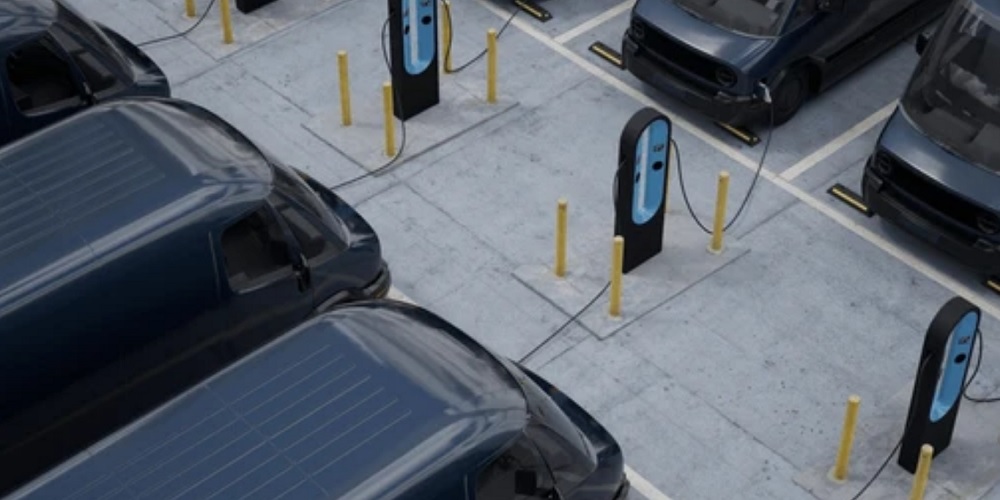5 factors affecting adoption of electric vehicles in municipalities

Despite rapid growth in the sale and adoption of electric vehicles (EVs), there are still significant barriers to widespread usage. According to a Consumer Reports survey of more than 8,000 adults, the top barriers focused on charging, range, and costs:
- 61%: charging logistics
- 55%: the limited number of miles that EVs can travel before needing a charge
- 52%: the high cost of buying and maintaining EVs
These mirror the concerns in the public sector. For municipal fleets and government policymakers, navigating this complex landscape requires evaluating how local conditions and planning shape EV adoption moving forward. Let’s examine each factor that affects the adoption of EVs in municipalities.
1. Charging infrastructure
Expanding EV charging infrastructure is essential for widespread adoption. While states like California have more than 14,000 public chargers available, several states have less than 100. Nationwide, there are just 152,568 charging ports as of September 2023 and only 34,359 fast charging ports. Not all of them are currently in operation.
Compare that to the estimated 900,000 to 1.8 million gas pumps in the U.S., and you can see how far we have to go. Key concerns include:
- Lack of charging stations in crucial locations: Strategically placing chargers in downtowns, multi-unit dwellings, workplaces, and along major transit corridors is vital for spurring adoption.
- High installation costs: Installation expenses for a two-port Level 2 public charging station can exceed $100,000 when factoring in hardware, construction, permitting, and backend software. DC fast chargers cost up to $150,000. Costs are higher still when electrical upgrades are required.
- Grid capacity limits: In areas with already strained grids, adding thousands of high-powered chargers requires expensive infrastructure upgrades. Utilities may lack the capacity to meet commercial charging demand.
- Coordination challenges: Deploying chargers on municipal property requires cooperating with utilities and private charging network companies on installation, maintenance, and payment systems. Complex permitting and outdated regulations can also delay projects.
- Charging logistics for fleets: Municipal fleets need adequate overnight charging to avoid disrupting daily operations. Fleet charging strategies must utilize decentralized options like in-depot smart chargers.
Expanding EV infrastructure requires planning by municipalities. Charger rollouts should be phased to match current and projected EV volumes, prioritizing high-traffic sites to maximize usage and visibility.
Partnerships between cities, utilities, and charging firms can help with cost and labor sharing. Municipalities should explore revenue-sharing deals to offset municipal capital costs and explore state and federal grant programs.
Government entities at every level should review the permitting process for potential ways to streamline and accelerate deployments.
2. Limited driving range
While some EVs now boast ranges of 300-500 miles, the average electric car range is 219 miles. The range also drops considerably in very hot or cold weather due to battery sensitivity. While the average vehicle owner drives less than 100 miles a day, range anxiety persists. The lack of public charging stations influences this concern. While about 80% of EV owners will charge at home, expanding the network of available charging stations is crucial to spurring adoption.
Municipalities can help reduce anxiety by making sure high-traffic areas also have access to fast charging stations and encouraging tow truck operators to carry portable chargers to avoid stranded EVs. Public education can also help, highlighting average driving needs, the availability of charging stations, and managing expectations.
Technology is constantly evolving. For example, the U.S. Department of Energy is developing a new lithium-air battery with four times the density of current Li-ion batteries, which would significantly extend driving ranges. Tracking and publicizing these types of breakthroughs can help accelerate the adoption of EVs.
3. EV procurement costs
While costs are dropping, EVs are still more expensive than internal combustion engine vehicles. This creates financial challenges for consumers and budgetary concerns for government entities. While maintenance and fuel savings can help offset higher upfront costs, procurement requires a significant adjustment to traditional budget lines.
There are also challenges when it comes to inventory. Demand for EVs has created lengthy backlogs, especially for specially configured vehicles like buses, heavy-duty trucks, or fire trucks. These types of vehicles are generally custom-built and not as readily available. Simultaneously, desired configurations may be unavailable, forcing consumers and municipalities to compromise or add costs for aftermarket additions and limiting the adoption of EVs.
Municipalities can address these challenges by conducting lifecycle cost analyses to demonstrate the long-term savings from electrifying fleets. Careful planning can help create realistic budget projections over time and phase in EV purchases. Fleet purchases represent large volumes for automakers, so planning advance or pre-orders can help lock in supply and pricing.
4. Aftermarket support
Aftermarket support is an area where there are fewer qualified technicians and parts available. Many dealerships lack hands-on EV experience, yet the vehicles have unique systems like battery thermal management that require special expertise. While training programs are evolving, they are typically clustered in urban and high-adoption areas, limiting access to rural drivers and fleets. Fleet technicians must also be trained on new maintenance procedures.
Since part supply chains are still developing, they can create long lead times for part replacements. Fleet managers will need to consider additional stock requirements to avoid putting vehicles out of commission for weeks.
Strategies for municipal fleets to overcome these barriers include:
- Taking advantage of EOM training programs
- Using third-party maintenance contracts to fill any gaps in experience
- Keeping a ready supply of high-wear components to minimize downtime
5. Careful planning
Municipalities must develop comprehensive strategies to address challenges. As part of the planning process, government entities should set target dates for transitioning to EV fleets based on assessments, budgetary constraints, and sustainability goals.
Development of the charging infrastructure also requires analysis to guide policy decisions and provide an equitable solution for buildouts. Community engagement can help identify any additional barriers and provide opportunities for public education and incentives.
Many communities start with pilot programs to evaluate real-world performance and gather data. This data can help make the case for future EV investment.
How Sourcewell can accelerate the adoption of electric vehicles
Sourcewell can help by connecting municipalities with vendors for vehicles, aftermarket parts, charging stations, telematics, and other services for EVs. Cooperative purchasing agreements are competitively sourced and ready for use, helping reduce procurement time. Since Sourcewell aggregates buying power from more than 50,000 government agencies and educational institutions, you can significantly lower costs. Review its suppliers and contracts, and download the Public Fleet Electrification Guide for more ways to overcome these barriers.
See how easy it is to get the EV fleet you need without the hassle, using Sourcewell’s cooperative purchasing program. Streamline the public procurement process by choosing from hundreds of suppliers already on contract. Sourcewell’s procurement experts competitively solicit and award contracts on behalf of 50,000 participating agencies in North America. Check out our EV contracts and more for free here.


